Round The World and other travels
A frequent flyer's collection of trip diaries
June 2013: West Sussex
This trip was the latest application of a technique that I had found myself using more and more: flying to a thoroughly familiar airport and then heading off in an unconventional direction. Previous examples included flying to Barajas airport in Spain and visiting Toledo rather than Madrid, and flying to Schiphol airport in the Netherlands for the purpose of seeing The Hague rather than Amsterdam. In this instance, the plan was to fly to London Gatwick and then eschew the big-city buzz of the UK capital and the seaside attractions of Brighton in favour of a drive around the lesser-known county of West Sussex. More specifically, my main objectives were Arundel and Chichester.
Arundel
 Arundel
is a small and pleasant market town situated on the banks of the
River Arun in the South Downs. In spite of its diminutive size, the
town is home to both a famous castle and a cathedral. The former is
without doubt the standout attraction: dating from the reign of
William the Conqueror, Arundel Castle has been the seat of the Dukes
of Norfolk for over 400 years. One of the current duke's ancestors,
Thomas Howard, led the English army that defeated invading Scots
(including King James IV) at Flodden, Northumberland, in 1513. To
this day, the family's coat of arms contains a version of the royal
coat of arms of Scotland that has been modified to show an arrow
piercing the mouth of the lion rampant.
Arundel
is a small and pleasant market town situated on the banks of the
River Arun in the South Downs. In spite of its diminutive size, the
town is home to both a famous castle and a cathedral. The former is
without doubt the standout attraction: dating from the reign of
William the Conqueror, Arundel Castle has been the seat of the Dukes
of Norfolk for over 400 years. One of the current duke's ancestors,
Thomas Howard, led the English army that defeated invading Scots
(including King James IV) at Flodden, Northumberland, in 1513. To
this day, the family's coat of arms contains a version of the royal
coat of arms of Scotland that has been modified to show an arrow
piercing the mouth of the lion rampant.
![]()
The visitor can easily spend a couple of hours or more at the castle. As well as seeing the main rooms of the interior, some of which are on a breathtakingly grand scale, other attractions include the castle keep, the extensive formal gardens and grounds, and the Fitzalan Chapel (see below).
 |
 |
 |
 |
 |
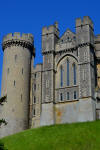 |
 |
 |
 |
 |
 |
|
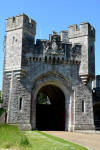 |
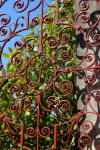 |
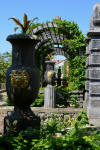 |
 |
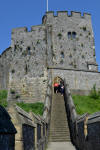 |
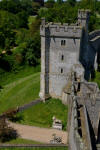 |
The streets of the town made for a pleasant stroll on a warm and sunny afternoon in early summer:
 |
 |
 |
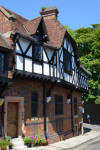 |
 |
 |
 |
 |
 |
 |
The second most notable building is the cathedral which, although not particularly old (it was dedicated as a church in 1873), is in the French Gothic style that is more suggestive of the 14th century. As such, it is a quite magnificent tribute to that long-gone age. It was raised to the status of cathedral in 1965 on creation of the Roman Catholic diocese of Arundel and Brighton.
 |
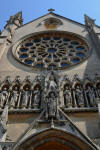 |
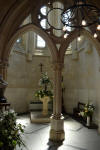 |
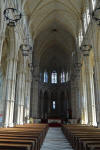 |
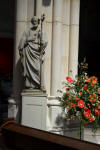 |
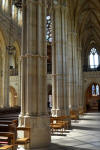 |
 |
Arundel contains another remarkable ecclesiastical structure in the shape of a genuinely ancient church building that has been split into two parts and two denominations, divided by a locked iron grille! This bizarre arrangement came about in the time of Henry VIII, when the church's original chancel and sanctuary were sold to the Duke of Norfolk to become the Fitzalan Chapel. This became part of the castle property and retained its adherence to Rome; it can be visited today by anyone with a ticket for the castle grounds. The western end of the building became St Nicholas' Parish Church in the Church of England, which can be entered directly from London Road in Arundel.
| St Nicholas' Parish Church (C of E) | The Fitzalan Chapel (RC) | |||||
 |
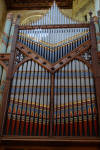 |
 |
 |
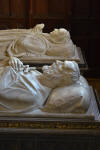 |
 |
|
 |
 |
|||||
| "Oh,
East is East and West is West, and never the twain shall
meet ..." Rudyard Kipling |
 |
||
| RIGHT: Looking eastwards from St Nicholas' to the "other side" |
Chichester
Despite its non-central location close to neighbouring Hampshire, Chichester is the administrative capital of West Sussex. With fewer than 25,000 inhabitants, it is a particularly small place to have city status, which may perhaps have been granted on the strength of its principal attraction, the medieval cathedral dating from 1075. The building has a mixture of Norman and Gothic features and, uniquely for one of England's ancient cathedrals, it boasts a free-standing bell tower. Leonard Bernstein composed his Chichester Psalms for the cathedral.
Other Chichester attractions include Bishop's Palace Gardens, the Chichester Cross monument, Pallant House Gallery and a healthy dose of Georgian architecture.
 |
 |
 |
 |
 |
 |
 |
 |
 |
 |
 |
 |
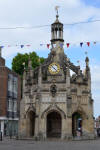 |
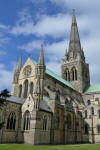 |
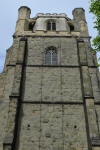 |
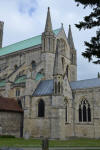 |
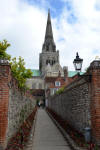 |
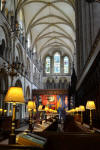 |
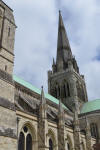 |
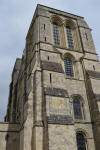 |
 |
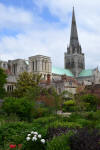 |
 |
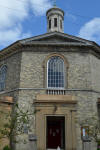 |






